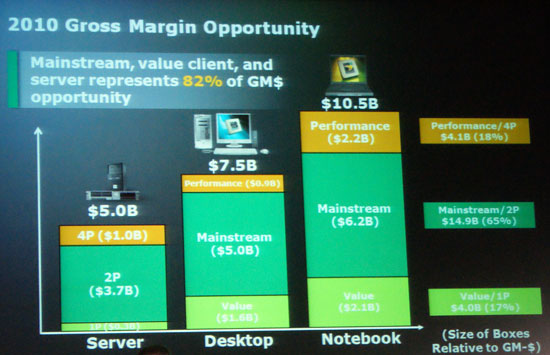The RV770 Story: Documenting ATI's Road to Success
by Anand Lal Shimpi on December 2, 2008 12:00 AM EST- Posted in
- GPUs
Building a GPU for the Masses
AMD put up this graph at its recent Financial Analyst Day:

The performance segment of the desktop CPU market is only about 7% of the pie and although it generates a disproportionately large amount of revenue it’s neither the biggest segment nor the biggest revenue generator in the market. That would be the mainstream segment.
ATI realized much of the same thing back in 2005. These high end GPUs were getting more and more expensive, while R300 tipped the scales at $399 over the coming years we’d see GPUs hit $499, $599 and go north of $600 at launch. The higher prices were due to increasing die sizes and techniques such as harvesting, ensuring that regardless of how big the GPU, revenues were protected.
A $399 R300 was close enough to the mainstream price points that ATI was able to scale it down months later to address other markets, but these days the time between the high end GPU introduction and the mainstream revisions of it has increased to 6 - 9 months. We still don’t have a mainstream derivative of NVIDIA’s GT200 architecture and chances are that we won’t until around 9 months after its introduction. With the GeForce GTX 280 launching at $600, for it to take 9 months to make a $200 derivative is doing the market a disservice in ATI’s eyes.
It was time to refocus. Instead of tailoring to the needs of the high end, ATI wanted to make a product that would be the best in the $200 - $300 range. To do so would mean that it would have to reverse the strategy that made it successful to begin with, and hope that somehow NVIDIA wouldn’t follow suit.










116 Comments
View All Comments
d0nnie - Wednesday, December 3, 2008 - link
Like many said before, this is truly one of the best readings ive had in a long time. Keep up the good work man!Zar0n - Wednesday, December 3, 2008 - link
Great article, it's excellent to have the back story of the GPU wars.It's kind like the planes/tanks on the history channel :)
5* Anandtech
ViperV990 - Wednesday, December 3, 2008 - link
Awesome article. Did NOT miss the sea of charts. At all.Loved every bit of the tale.
Easily the best PR a company can get.
However I was kinda hoping for a little bit more info on the RV670. What did *that* team go through when making the part that is RV770's direct (or no?) predecessor?
Frallan - Wednesday, December 3, 2008 - link
Im acctually concidering buying a GFX to support the company that allowed this interview. Its easily one of the best Ive read.
hrishi2das - Wednesday, December 3, 2008 - link
A great article... very well written and personal...Can Anand with his great contacts get us a backstory on the Core 2 arch. That would be another great article.
malmal - Wednesday, December 3, 2008 - link
As an NVDA shareholder, having a *huge* amount of unrealised loss in the shares, I bought the 4870 a month ago.A testament to how good the 4870 is at its price point. It just makes sense.
piesquared - Wednesday, December 3, 2008 - link
All preferences aside, I have to say that was probably, hands down, the best article i've read in a long, long time. Talk about capturing your audience.Tremendous insight.
rocky1234 - Wednesday, December 3, 2008 - link
Well I must say this is a good article because it is something different good work on this one. I do have to ask this has AMD been making GPU's for 8 years really..okI know ATI has for sure but they were not part of AMD then if AMD has been then oops I guess I never owned one of their GPU's before they bought ATI.
nowayout99 - Wednesday, December 3, 2008 - link
I have to echo the other comments here, wonderful article! One of the best ever on Anandtech.And thank you, ATI, for giving the community this kind of access to your hard workers.
leonxki - Wednesday, December 3, 2008 - link
What a great story. Really shows how long it can take to make a significant change towards a process that is right for the end user. All those external factors e.g no GDDR5 at the time and G80s prosperity can really suck out an engineers motivation. Good thing those few engineers stuck to the task.The card itself looks so neat and well designed from a bird's eye view. To see how the internals were pateiently designed too is awesome!
The article showed how the RV770 came to life using just words. Time to introduce my pc to life using this card I say :-)
I also join the best-article-I've-read-wagon on this one.